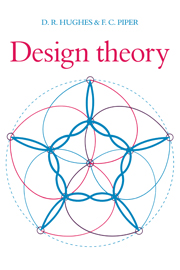4 - 3-Designs and related topics
Published online by Cambridge University Press: 08 January 2010
Summary
Introduction
There are many known examples of 2-designs and, even with the restriction that they are symmetric, we have already constructed several infinite families. But t-designs with t > 2 are much rarer. Although (as we proved in Theorem 1.5) t-structures exist for arbitrarily high values of t, there are no known nontrivial 7-designs and, in fact, the first non-trivial 6-designs were not discovered until 1982 (see [6]). In this chapter we look at some of the important t-designs with t ≥ 3 and at various methods of constructing such designs.
Any t-design must be the extension of a (t – 1)-design and in Section 4.2 we prove Cameron's Theorem. This says that there are very few possibilities for starting with a symmetric design and extending it to a 3-design. This leads us to extending symmetric Hadamard 2-designs to get Hadamard 3-designs which, in turn, leads to the construction of the little Mathieu designs in Section 4.4.
Just as we used the 2-homogeneous groups ASL(2, q) for q ≡ 3 (mod 4) to construct the Paley designs ℒ(q), in Section 4.3 we use the 3-transitive groups PGL(2, q) to construct some 3-designs. We then, in Section 4.5, discuss some of Alltop's ideas for constructing (t + 1)-designs from t-ransitive groups and indicate how to use the 3-transitive groups PGL(4, 2n) to construct some 4-designs which, in fact, turn out to be 5-designs. Finally, in Section 4.6 we prove a generalisation of Fisher's Inequality for 2s-designs with s ≥ 1, which leads to the concept of tight designs. Both Sections 4.5 and 4.6 contain very little detail and any interested reader will have to consult the relevant references.
- Type
- Chapter
- Information
- Design Theory , pp. 127 - 152Publisher: Cambridge University PressPrint publication year: 1985



